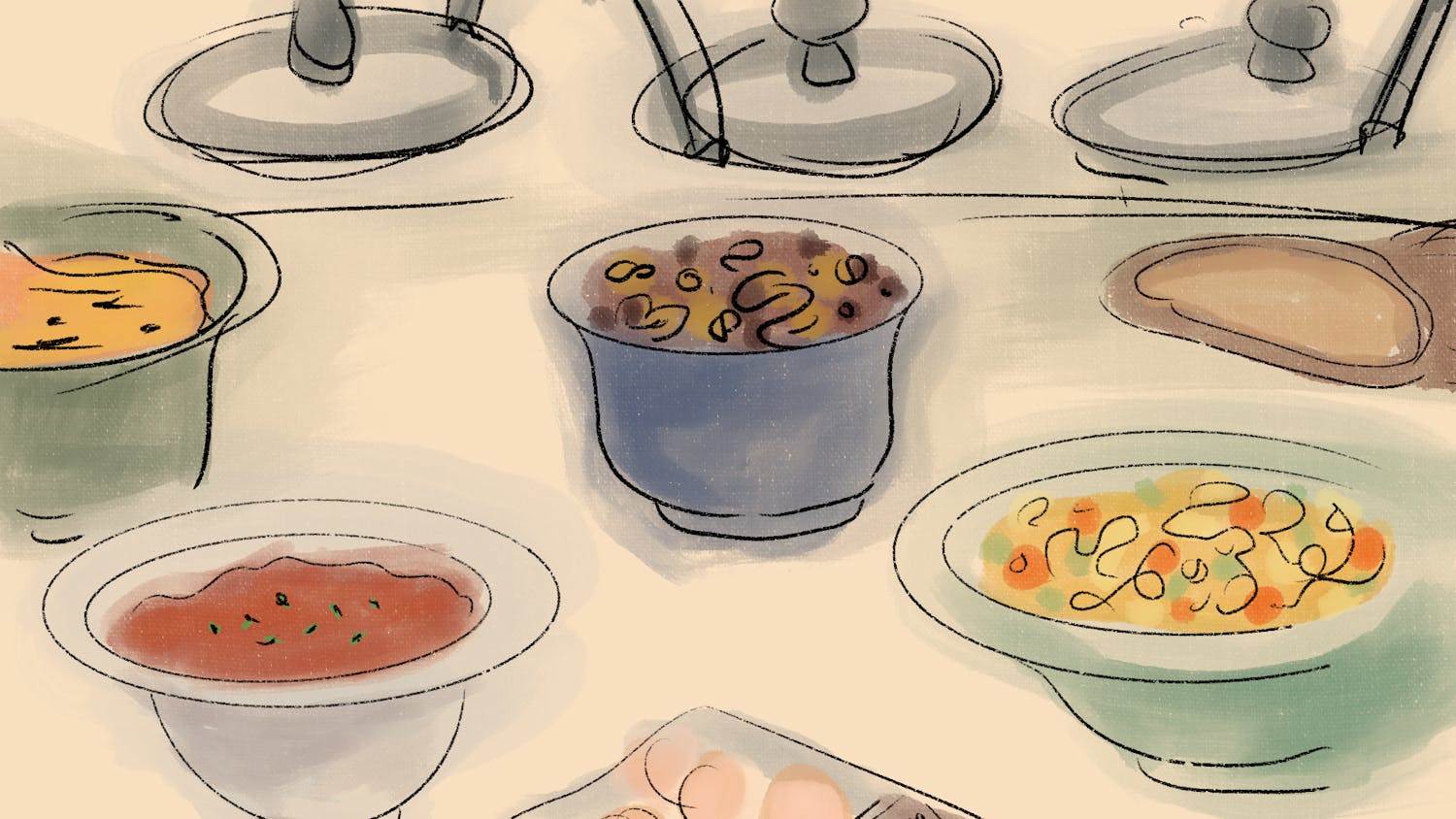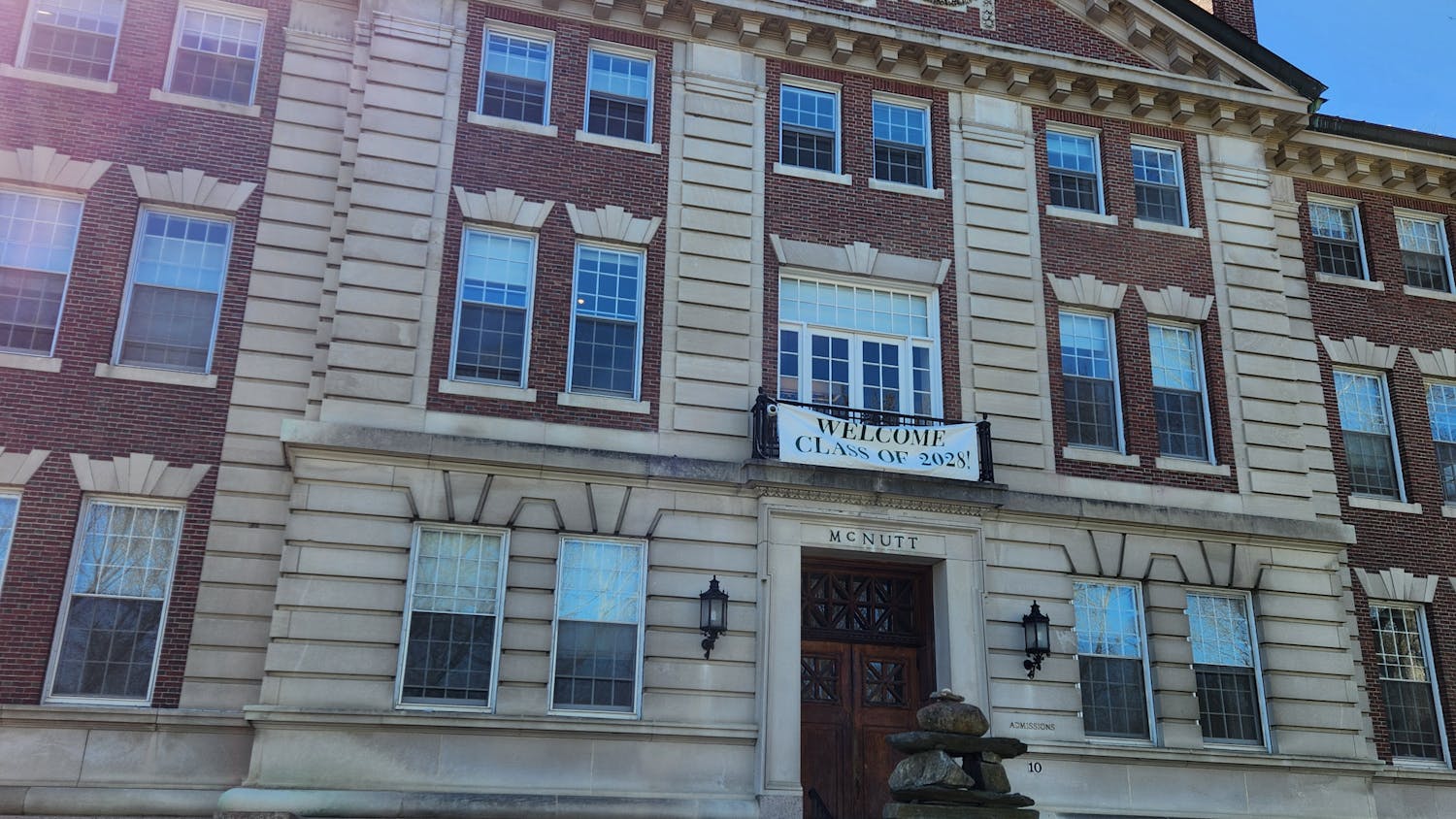We could all be flâneurs — the ambling, idling scholars of 19th century Paris. We could all soak in the rich, historic landscape of our frigid hamlet.
Balzac called the activity the “gastronomy of the eye.” Baudelaire deemed them “botanists of the sidewalk.” They feasted upon the urban sweep as if it were a museum — the citizens its patrons and the architecture its pieces, curated and juxtaposed to maximize experience.
Yet rarely do we think of Dartmouth’s campus as a museum. Rather than gastronomy, we drive through our buildings in a manner more akin to a fast food restaurant. We see everything as its utilitarian interiority — the Hopkins Center contains the arts, Collis Center houses a cafe, etc. Like rock strata, our history is marked by our architecture, revealing 250 years of artistic and cultural evolution.
I’m not asking you to be some snobbish, croissant-loving Frenchman, but merely an observer with a curiosity for how Dartmouth took its shape.
Why do we glance over our architecture so easily? To an untrained eye, Dartmouth is just brick, mortar, green shutters and copper roofs. Even the newer buildings, like Fahey-McLane and McLaughlin residence halls, maintain this theme. It all seems — to use the technical art history term — meh. Are we just an uninspired campus, mired by conservatism and waging a Sisyphean battle with our past? Why don’t we join the über-modern Gehry bandwagon like MIT and Princeton? Is there some old architectural staunch atop Baker Tower, demanding the good ol’ days when brick was strong and manly, only conceding the Black Family Visual Arts Center to appease the liberal “youts”? To find these answers we must look back into our very beginnings as an institution to understand the complexities we face with such a classical, colonial heritage.
Our history can be read in a simple panorama of the Green. In the center, Dartmouth Row stands as our bedrock, containing some of the oldest buildings on campus.
“As a set of condensed, coherent original buildings, Dartmouth Row is unmatched in collegiate architecture, only rivaled by the University of Virginia’s Rotunda and pavilions designed by President Thomas Jefferson,” art history professor Marlene Heck said.
Dartmouth Hall embodies the quintessential colonial New England look, the Georgian style standing church-like, white, grand and pure to emblematize our heritage as a school for Native American missionaries.
We are also the only Ivy which still has its founder’s home, she points out. (Granted, Cornell University was founded by Satan, but even he didn’t live nearby.) Eleazar Wheelock’s original house is now Robert’s Flowers on West Wheelock Street across from Collis.
The 19th century presented many architectural movements, each introducing an incredible variety to the basic Georgian unity. We see buildings like Rollins Chapel, with its Romanesque arches and warm granite tones that enliven the austerity of our New England traditionalism. We also get neoclassicism, a return to robust and geometric ancient Greek models, in Webster Hall, Collis, McNutt Hall and Richardson residence hall, which simultaneously diversify yet compliment their surroundings. Then there’s Georgian Revival, a nostalgic referral to our College’s and nation’s past, which brings us Silsby Hall, Sanborn Library and Baker Library (modeled after Independence Hall),
A movement Dartmouth failed to follow in this century was the gated campus. Think of the famous gates of Harvard, Yale, Brown and Princeton Universities, where gates like St. Peter’s distinguish their ethereal campuses from the everyday Purgatory of their surrounding towns. Naturally secluded, Dartmouth maintains a humble unity with Hanover, meaning we open ourselves to the everyday ragamuffins of the non-Ivy world. The horror! Like Troy we allow ourselves to be invaded by townies. Yale laughs at our inclusivity.
Then things took a turn after the Second World War when President John Sloan Dickey came along. A diplomat during the war, he came to Dartmouth seeking to revitalize the campus and turn toward global affairs. In order for Dartmouth men to confront these new issues, the campus had to be international, interactive and of the moment, and architecture was an integral part of that vision. Modernism — that anti-historical, angular, glassy, metallic style, part of the post-war inventive spirit — was certainly of the moment. It was all about ethos: “Build modern, be modern!”
The Hop, the Choates residence halls, Leverone Field House, Thompson Arena, Fairchild and the former Bradley and Gerry Buildings all came out of Dickey’s modernist movement.
To some, this may seem to be the Razzies of Dartmouth architecture.
“Modernism eschewed color, decoration, history, where the front door is, all the things people liked and expected out of buildings,” Heck said.
In other words, it’s the middle finger of art movements. It’s no surprise that these new buildings shocked many. I mean, a building without a clear entrance is at the very least a safety hazard. It strove to be unfamiliar, unknown, unapproachable, unreadable, essentially un-architecture. To have the hallowed Green perverted by the glassy monstrosity that is the Hop was sacrilege. The Hop is our Eiffel Tower in a way — hated at first for perverting sacrosanct ground, but gradually favored as rigid tastes softened and we became croissant-loving Frenchmen at long last.
Many schools tuck their modernist buildings away, as UVA has done to its architecture and education schools, but Dartmouth proudly asserts its boldness. Modernism promised to change the world, and that’s exactly what Dickey wanted — to transform Dartmouth into the best liberal arts school in the world.
Why don’t we just tear down the Choates or Leverone, and like in an architectural “Weakest Link,” wave a curt good-bye with a wrecking ball? Miley Cyrus for a Green Key dual concert and demolition fest, anyone? Granted 1950s construction wasn’t the best. It often leaked or rusted, but that’s the price of progress. Each building is a vestige from another time, which preserves our past. Like an appendix or tailbone, each building tells a story of who we have been. It’s not enough to say, “We took pictures, so here’s a scrapbook, history nerd.” Think of how dull college tours would be if all the buildings were shiny, ultra-sleek monoliths?
Most often, colleges demolish and rebuild, demolish, rebuild. But then there would be no variety left in our dorms. What makes us unique, according to the chair of the department of architectural history at UVA Richard Wilson, is our juxtaposition between our historic buildings, especially on the Green. Dartmouth director of campus design and construction John Scherding points out that many schools, such as Princeton, have binary campuses, which fail to integrate their modern buildings into their older ones as well as Dartmouth has.
Therefore, with such an entrenched historical standard, we must innovate within our framework, or as Scherding calls it, build “contemporary contextual.” Every new building can’t be the showpiece, otherwise we’d end up with, as Scherding’s colleague calls it, “a petting zoo of famous architects’ projects that don’t match.”
Or as Heck puts it, dorms and classrooms are background, so they want to be good neighbors and remain contextual.
We shouldn’t be subservient to our past, however, freezing our campus in time like Ted Williams’ head. Big name buildings, like the VAC, the Hood and Geisel Medical School, are where experimentation takes flight. We have to learn from our modernist past, and not ruffle the same feathers we did 50 years ago. Modernism taught us that people desire continuity and classical beauty. As Scherding observes, we would metal monstrosity sitting in front of Sanborn right? We’ve made this mistake before. Both Scherding and Heck agreed that the Murdough Center, that angular, modernist black hole at the end of Tuck Drive is the bane of the campus. Architects and snobs loved this stuff. People don’t.
We have a great opportunity with the Hood expansion to innovate within our historical framework. A four-year project, the Hood addition will be a strong marker of where Dartmouth is headed architecturally, and could be our next great leap forward.
So where are students left in all this? If Baker is just the pointy KAF building and Sanborn where all the future homeless people read dusty paper PDFs, who cares about George’s Revival?
When you take the time to consider and value your surroundings, they appreciate in worth. You become a patron and a steward, not a user.
As James Baldwin claimed in his essay “Stranger in the Village,” “People are trapped in history, and history is trapped in them.”
At Dartmouth, you are stuck in a campus of historical surfeit, and you become part of its timeline. Talk a walk, ponder. Anyone can be the flâneur. Then put it on your resume. Employers will wonder how you hold down so many jobs. And speak French!



